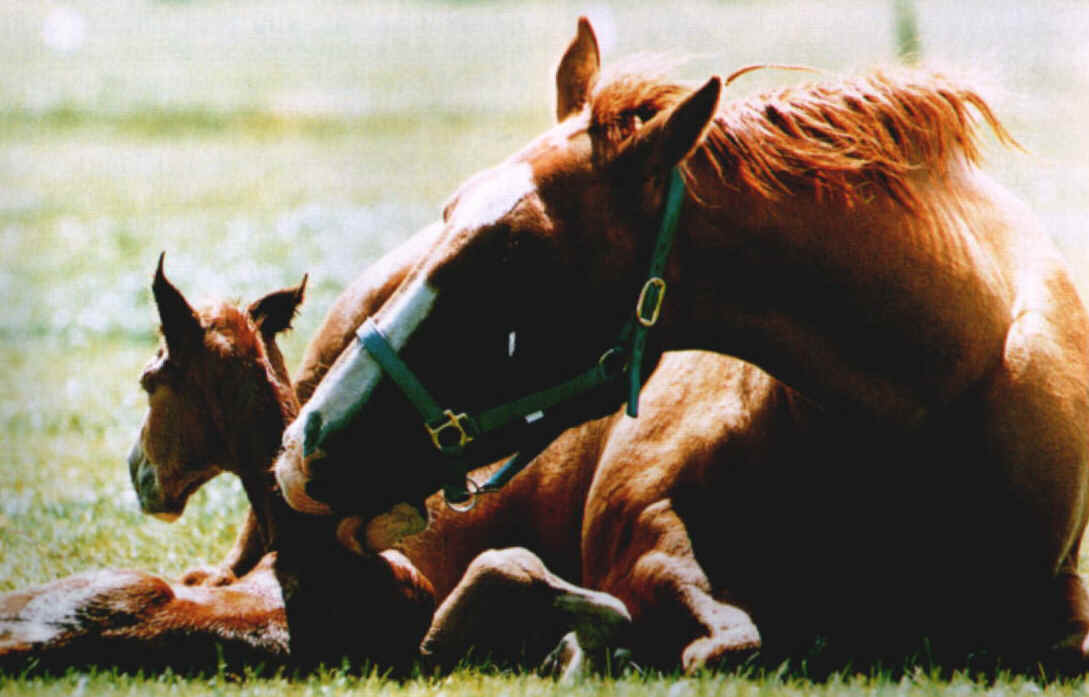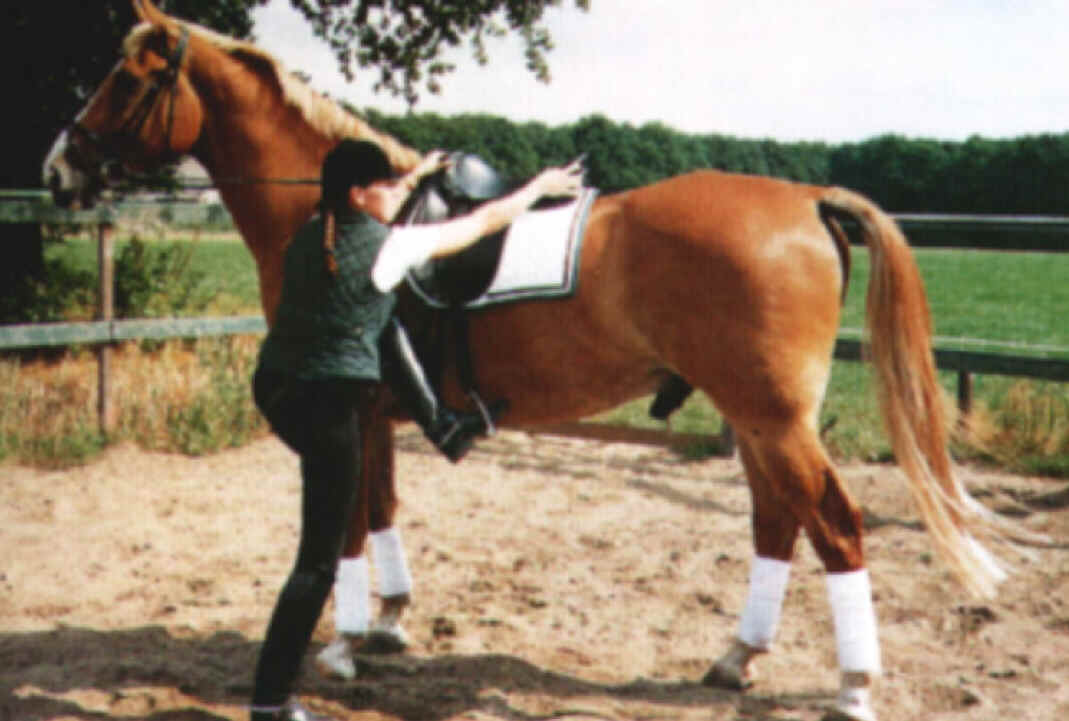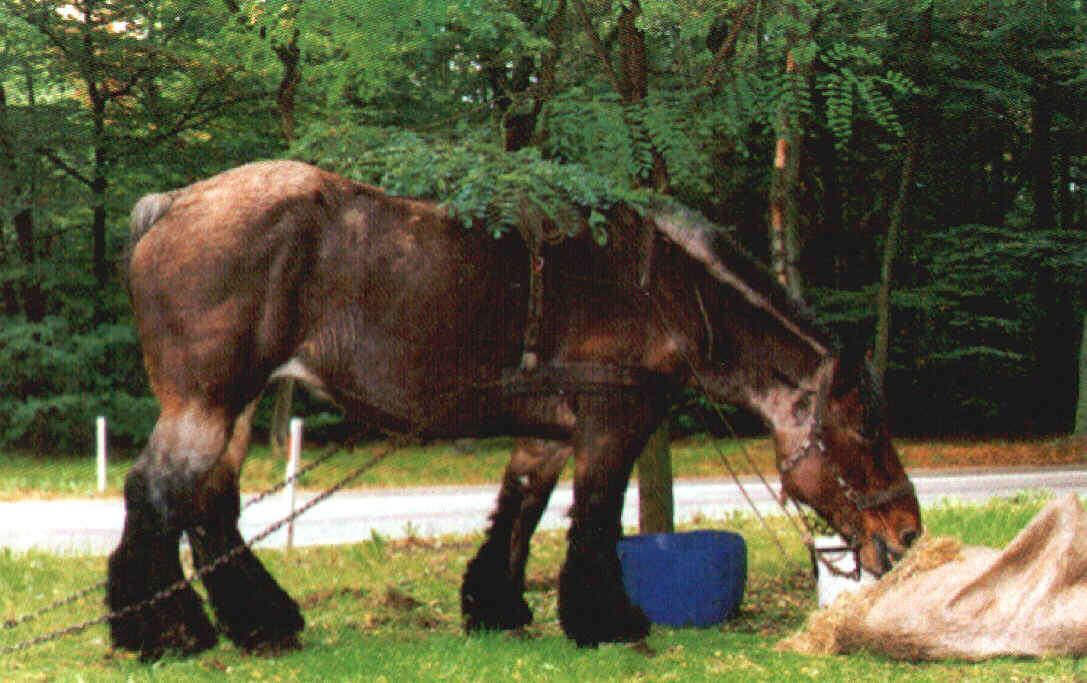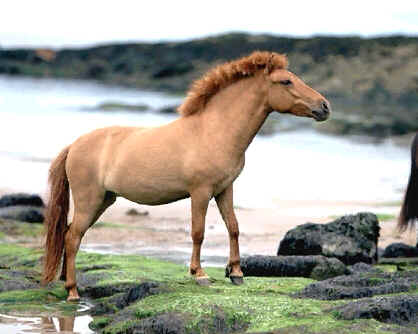



ICELANDIC PONY
 Breed
of pony descended from ancient horses brought to Iceland from
Norway by the Vikings in the 9th century. The Icelandic pony
stands about 123 to 132 cm (about 48 to 52 in, or 12 to 13 hands)
high at the withers. (the high part of the back, located between
the shoulder blades), and weighs about 380 to 410 kg (about 835
to 900 lb). A compact but powerful body and strong legs enable
this pony to carry a full-grown man at rapid speed over a long
distance. The neck is short and muscular, and the head is
straight with a wide forehead and large jaws. The ears are small
and the nostrils flared. The Icelandic pony's coat, which grows
almost to the ground in winter, appears in almost any color or
color combination. Its small stature qualifies it as a pony,
which is characterized by heights from 102 to 153 cm (40 to 60
in, or 10 to 15 hands) at the withers. Icelanders, however, call
it the Icelandic horse. The Icelandic pony is five-gaited, a
quality unique to this sure-footed pony. Its five gaits are the
walk; the trot, for crossing rough country; the gallop; the
skeid, covering short distances at a fast pace; and the tölt, a
running walk known to many horse-show competitors and fans. Few
horse breeds have maintained as much purity as the Icelandic
pony. The extinct Lofoten breed, from which the Icelandic pony
descends, was influenced by the ancient tarpan and the tundra
horses, both ancestors of modern horse breeds, and the Asian wild
horse. Shetland ponies were crossed with Icelandic ponies for a
brief period, but there has been no outside influence on this
breed for more than 800 years. Selective breeding of the
Icelandic pony has been practiced periodically by farmers to
strengthen its best characteristics. Since the Vikings settled
Iceland, this pony has been used as a pack (cargo-carrying),
harness (cart-pulling), or riding animal, and for meat. Because
the Icelandic pony can be raised outside during the Icelandic
winter while cattle cannot, horse meat has been a staple of the
local diet for centuries. The Icelandic pony also is used in
sports events, including racing, cross-country riding, and
dressage (guiding a horse through a series of complex maneuvers
with slight movements of the hands, legs, and weight by the
rider). About half of all Icelandic ponies live in a semi-wild
state, roaming free in open areas of the country year-round.
Breed
of pony descended from ancient horses brought to Iceland from
Norway by the Vikings in the 9th century. The Icelandic pony
stands about 123 to 132 cm (about 48 to 52 in, or 12 to 13 hands)
high at the withers. (the high part of the back, located between
the shoulder blades), and weighs about 380 to 410 kg (about 835
to 900 lb). A compact but powerful body and strong legs enable
this pony to carry a full-grown man at rapid speed over a long
distance. The neck is short and muscular, and the head is
straight with a wide forehead and large jaws. The ears are small
and the nostrils flared. The Icelandic pony's coat, which grows
almost to the ground in winter, appears in almost any color or
color combination. Its small stature qualifies it as a pony,
which is characterized by heights from 102 to 153 cm (40 to 60
in, or 10 to 15 hands) at the withers. Icelanders, however, call
it the Icelandic horse. The Icelandic pony is five-gaited, a
quality unique to this sure-footed pony. Its five gaits are the
walk; the trot, for crossing rough country; the gallop; the
skeid, covering short distances at a fast pace; and the tölt, a
running walk known to many horse-show competitors and fans. Few
horse breeds have maintained as much purity as the Icelandic
pony. The extinct Lofoten breed, from which the Icelandic pony
descends, was influenced by the ancient tarpan and the tundra
horses, both ancestors of modern horse breeds, and the Asian wild
horse. Shetland ponies were crossed with Icelandic ponies for a
brief period, but there has been no outside influence on this
breed for more than 800 years. Selective breeding of the
Icelandic pony has been practiced periodically by farmers to
strengthen its best characteristics. Since the Vikings settled
Iceland, this pony has been used as a pack (cargo-carrying),
harness (cart-pulling), or riding animal, and for meat. Because
the Icelandic pony can be raised outside during the Icelandic
winter while cattle cannot, horse meat has been a staple of the
local diet for centuries. The Icelandic pony also is used in
sports events, including racing, cross-country riding, and
dressage (guiding a horse through a series of complex maneuvers
with slight movements of the hands, legs, and weight by the
rider). About half of all Icelandic ponies live in a semi-wild
state, roaming free in open areas of the country year-round.
Darmoore Pony - Exmoor Pony - Fjord -Hackney - Highland Pony - Icelandic Pony - Rocky Mountain Pony - Welsh Cob Welsh Mountain Pony